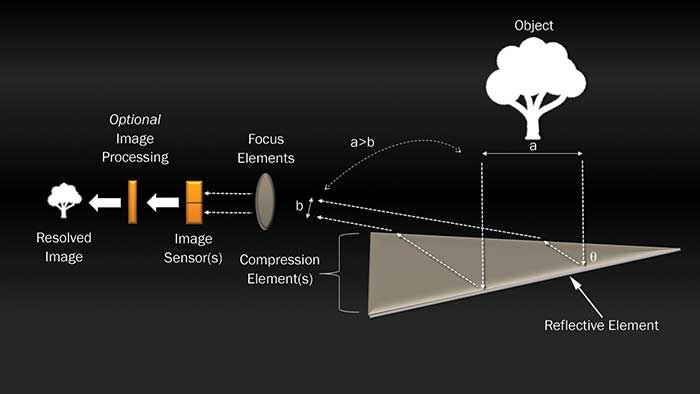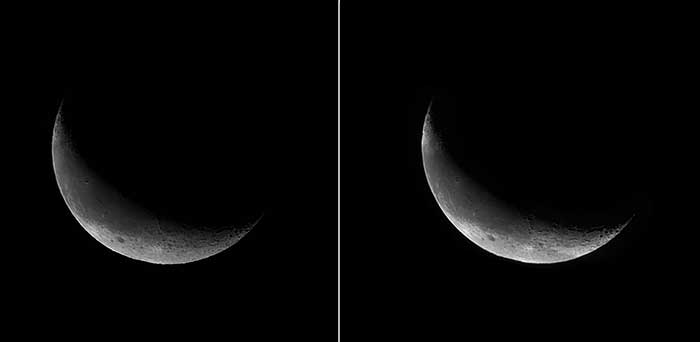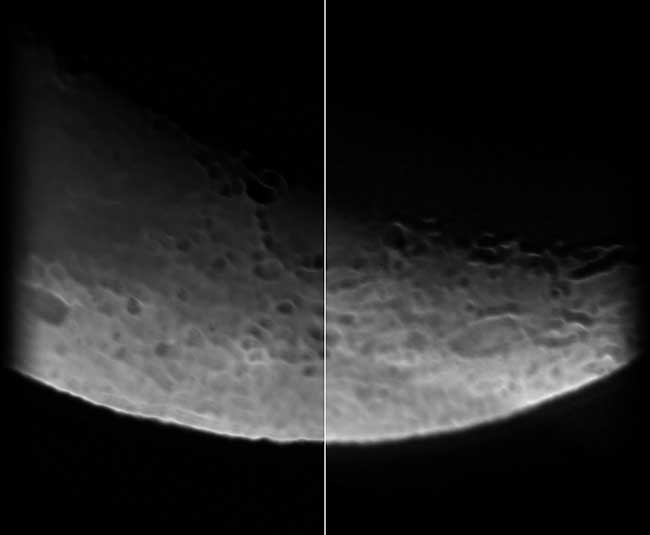Excellent overview of the technology
Flat Surface Lens Overcomes Limitations of Conventional Optics Photonics Spectra
Aug 2017 An increased aperture-to-depth ratio and a smaller lens stack open possibilities from telescopes to camera lenses in smartphones.
ELIZABETH HOWELL, Space and Science Journalist
The telescope has been used for more than 400 years. Although there have been many designs created for looking at distant objects, there is a fundamental weakness with the lens system. By necessity, telescopes use curved lenses — which are prone to aberrations. For the first time, a novel flat surface lens system offers the potential for better resolution from a significantly more compact size.
The flat lens system gathers about 27 percent more light than a comparably sized curved aperture with squared corners. The design increases the aperture-to-depth ratio in devices that currently have depth limitations, such as camera lenses in smartphones. Increasing the aperture size of a curved lens stack requires substantially increasing the device depth; for every inch in aperture of a curved lens system, roughly 2 to 4 inches of depth is required. By contrast, this flat surface technology enables an approximate aperture-to-depth ratio of 1:1, and thus the form factor benefits.
 Schematic representation of the compress-before-focus technique. Light from the object enters the first surface of the reflective wedge (distance a), which is reflected back up. The light refracts upon exiting and is compressed (distance b). The light is then focused onto an image sensor, creating an image. Courtesy of NexOptic Technology Corp. Schematic representation of the compress-before-focus technique. Light from the object enters the first surface of the reflective wedge (distance a), which is reflected back up. The light refracts upon exiting and is compressed (distance b). The light is then focused onto an image sensor, creating an image. Courtesy of NexOptic Technology Corp.
Flat surface minimizes aberrations
Using flat surfaces for the refraction — rather than conventional curved surfaces — avoids many of the challenges commonly associated with projecting an image from a curved lens surface onto the flat surface of a sensor. For example, problems include aberrations such as spherical, coma and petzval, in which a flat object normal to the optical axis cannot be brought properly into focus on a flat image.
These issues do not occur with a flat surface. Although there are still some aberrations associated with projecting the image from the flat surfaces onto the flat sensor, this design minimizes these in a compact space. The prototype’s technology is also suited to applications that require viewing distant objects, but in a depth-limited space.
Traditional telescope designs produce higher-quality images by increasing the focal length and the aperture. If the end goal is a smaller device, however, this design poses obvious limitations. Another approach is using folding optics, such as a Cassegrain design, which combines a primary concave mirror and a secondary convex mirror. However, this produces aberrations such as spherical, coma or astigmatism, depending on the type of Cassegrain utilized. The flat-surface lens reduces these aberrations by compressing light in less space. This compressed light can then be focused on an image plane using substantially smaller optical elements. Engineers were able to use off-the-shelf materials for the optics to reduce cost and complexity.
Designing the system, however, did produce several challenges. One was in selecting the correct materials with predictable Abbe numbers that were congruent with the device geometry. An Abbe number describes how the refractive index of a material changes with wavelength (color). This change in refractive index with wavelength can result in a “rainbow” effect sometimes called chromatic dispersion. Designing the system to eliminate chromatic dispersion in a compact space was a central focus of the design.
 A nearly full-disc image of the moon obtained by NexOptic’s prototype, Blade Optics, with its flat surface lens technology, near Tucson, Ariz. (March 2017). Courtesy of NexOptic Technology Corp. A nearly full-disc image of the moon obtained by NexOptic’s prototype, Blade Optics, with its flat surface lens technology, near Tucson, Ariz. (March 2017). Courtesy of NexOptic Technology Corp.
Further, the prototype was challenging to model in available lens design software because refraction was happening on flat surfaces (instead of typical curved surfaces), the prototype used a 3D off-axis light path (instead of typical single optical axis), and required manipulation of surfaces in 3D space (instead of typical 2D space). This difficulty was overcome as engineers used enhanced software and gained more experience working with the flat surface technology. Lens design software is critical for predicting lens performance parameters like image sharpness, distortion, resolution, contrast and uniformity. This software modeling effort led to the realization that a well-designed flat-surface lens could work well for compact long-range imaging solutions. And by using knowledge gained from the prototype’s testing, which included taking images of the moon, more refinements will be made to the technology.
Astronomical images
These images of the moon were captured using a 5-in. equivalent aperture, proof-of-concept prototype telescope and compared to images from a Schmidt-Cassegrain 5-in. aperture telescope. They were captured in March 2017 near Tucson, Ariz., and subject to similar image processing techniques. Both telescopes had a similar field of view of about 0.25 degrees, requiring an average of about nine images to cover the surface of the full moon as seen from Earth.
 Moon images captured near-simultaneously outside Tucson, Ariz. in March 2017 using a standard Schmidt-Cassegrain telescope (left) and NexOptic’s prototype (right). Courtesy of NexOptic Technology Corp. Moon images captured near-simultaneously outside Tucson, Ariz. in March 2017 using a standard Schmidt-Cassegrain telescope (left) and NexOptic’s prototype (right). Courtesy of NexOptic Technology Corp.
The flat lens prototype’s focal length is designed for distances that are 13 kilometers away or more, which made it more suitable to capture astronomical images than terrestrial images. Changes will be needed to adapt the focal length for a terrestrial application, which would involve images of objects roughly 5 kilometers away.
Standard, well-known image processing techniques were utilized for both sets of images, obtained with the prototype telescope and the comparison telescope. For the most part, the imaging team used open-source programs available on the internet, such as ImageJ, a program that performs image processing. No unique image processing was required for the prototype telescope, despite its square aperture.
 A side-by-side comparison of moon images obtained by a standard Schmidt-Cassegrain telescope (left) and NexOptic’s prototype (right). Images were near-simultaneously captured near Tucson, Ariz. (March 2017). Courtesy of NexOptic Technology Corp. A side-by-side comparison of moon images obtained by a standard Schmidt-Cassegrain telescope (left) and NexOptic’s prototype (right). Images were near-simultaneously captured near Tucson, Ariz. (March 2017). Courtesy of NexOptic Technology Corp.
Although it is possible to correct some chromatic aberrations with image processing software, the prototype optically corrects these aberrations in a compact space. While the team anticipated using image processing to correct an offset between red, green and blue, these colors were properly aligned in the images and did not require further processing.
Image processing was performed using the following steps: white balancing the images, merging the images and taking the median values for each pixel, and then stitching the images together to make a complete moon image. These steps allowed for lightly processed images; of note, many consumer cameras today are also capable of doing this type of imaging using the camera hardware itself. To more fully process the images, a common reconstruction filter — the Lucy-Richardson deconvolution — was used.
The imaging campaign with the prototype demonstrated that the science of using flat surface elements in a lens design is sound, and that it is possible to produce quality images using a much more compact telescope design than other designs available on the market.
The lens stack was developed and constructed by Spectrum Optix Inc. of Calgary, Alberta, Canada, in conjunction with Ruda-Cardinal Inc. of Tucson, Ariz. The company has entered into an option agreement to become a single corporation with NexOptic Technology Corp. of Vancouver, British Columbia, Canada.
Meet the author
Elizabeth Howell is a freelance space journalist and communications consultant based in Ottawa, Ontario, Canada; email: contact@elizabethhowell.ca.
Flat Surface Lens Telescope Specifications
The flat-lens surface design has shown promise in telescope designs, specifically because the lens stack depth is thinner than conventional telescope designs. For a telescope, the lens system is housed in an encasement approximately 5.5 inches deep at its widest part with a diagonal aperture of approximately 5 inches. A 3.2-megapixel camera was used for prototype testing.
Selected specifications of the prototype include:
• Focal length: 1460 mm
• Aperture: 89.6 × 89.6 mm, square
• Spectral band: 486 to 656 nm
• Field of view: 0.2 degrees × 0.2 degrees
• Resolution: 2.7 arcsec
• Overall dimensions of device: 8 in. tall × 9.5 in. wide × 5.5 in. deep (at its widest part)
• Hyperfocal distance: 6.8 km
The system compresses (or concentrates) the light before it is focused. By compressing the light, the design reduces the size required in subsequent conventional optical elements. This allows the physical depth to be reduced significantly, while maintaining a long effective focal length, allowing for a more compact design. The trade-off is that the design is wider and taller than conventional imaging optics. While the technique of “compressing before focusing” is sometimes used in telescope design, this particular design allows compression of light in a uniquely short distance.
Flat Lenses Suited for Smartphones
A smartphone optical design requires a thin depth. With additional engineering, the flat surface lens can be scaled and is well-suited for smartphones because of its high aperture-to-depth ratio. Work is ongoing to refine the lens design to more efficiently enable smartphones to create high-resolution images of objects at farther distances.
Computer-generated image simulations indicate that the new optical system design for smartphones has the potential to significantly increase the light-gathering area compared to lens systems in the current generation of smartphones.
Because the geometry of the flat-surface lens can be scaled up or down according to the size required, the lens can be adapted for laser light or monochromatic light, for narrow fields of view (e.g., in military, space and binocular/spotting optics) or wider fields of view (e.g., in sports optics and medicine).
While flat-lens smartphones are an imminent opportunity, as the technology works outside the visible spectrum, other applications could include long-range infrared imaging for terrestrial and space applications. Another possibility is cameras for autonomous vehicles, which currently have large, protruding lenses. The compact form factor may also enable other types of devices as the technology improves.
NexOptic is developing a mobile device prototype based on industry feedback, completing detailed optical designs, defining various tolerances for its lens stack, and sourcing materials.
photonics.com |








